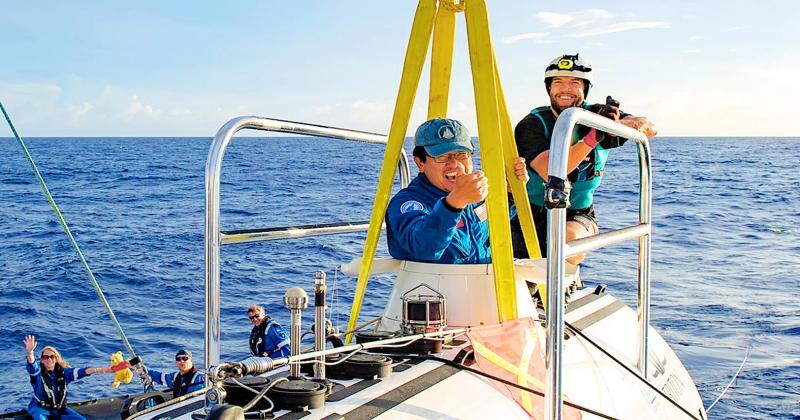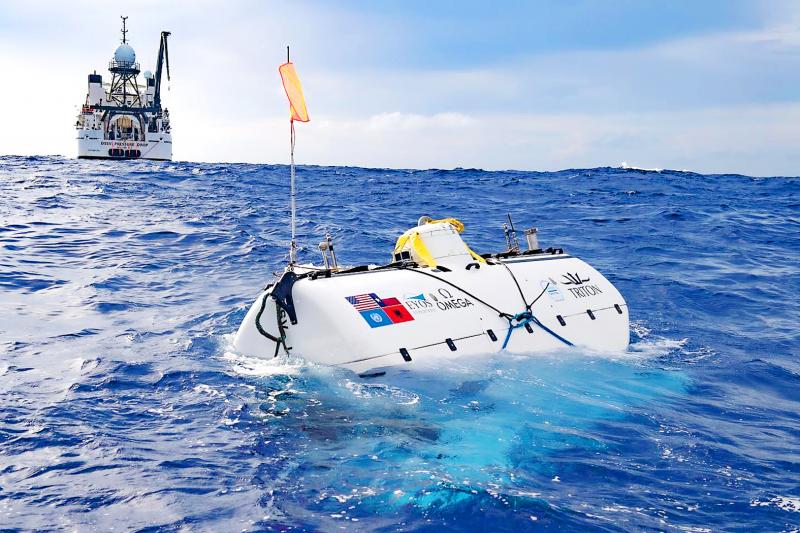Taiwanese-American Lin Ying-Tsong (林穎聰) last month became the first person from Asia and the 12th in human history to dive into the deepest part on Earth, the Challenger Deep in the Mariana Trench.
Lin, 45, an expert in deep sea acoustics with the Woods Hole Oceanographic Institution (WHOI) in Massachusetts, joined US adventurer and Caladan Oceanic founder Victor Vescovo, 54, on June 22 in a descent to the central pool of the Challenger Deep, the deepest point of the trench, which lies at a depth of more than 10,900m.
The pair made the descent in a submersible named Limiting Factor, a US$37 million two-seater commissioned by Vescovo from Triton Submarines.

Photo courtesy of Michael P. Moore
Unlike astronauts who have to wear a spacesuit, they did not experience significant changes of atmosphere, temperature or humidity in the submersible, Lin said in a telephone interview with the Taipei Times on Tuesday last week, after he returned to Massachusetts.
Inside the submersible’s capsule the pressure was kept at one standard atmospheric pressure, while the temperature dropped from about 28 ° C to 20 ° C during the dive and climb, he said, adding that the dive and the return climb took a total of 10 hours.
There are three windows in the capsule, and when looking out from the window beneath their feet, he felt as if he was doing a “seawalk,” Lin said.

Photo courtesy of Caladan Oceanic
The ocean bottom appeared to be an otherworldly desert of deadly gray, where only limited species, such as amphipods, can survive the extreme conditions, he said.
When ascending to the surface, he saw, from the depth of nearly 300m, sunlight gradually extend into a carpet of radiance that brought all colors back, he said, describing the scene as a “sunrise in ocean.”
Maintaining the balance of oxygen and carbon dioxide in the capsule was a matter of life and death, so Vescovo, who was piloting the craft, had to regularly check that oxygen was evenly released, Lin said.
The submersible was equipped with an oxygen reserve sufficient to last two passengers for four days.
Lin’s descent was part of the Caladan Oceanic’s Ring of Fire expedition that began last month, which also included dives by former NASA astronaut Kathy Sullivan — the first US woman to complete a spacewalk — and Kelly Walsh — the son of Don Walsh, the first person to descend to the Challenger Deep, in 1960.
Asked how he got involved in the team, Lin said he received an e-mail invitation from Vescovo, whom he had not met before, in late May after he returned from a cruise to measure underwater acoustics for an offshore wind farm project.
While Vescovo reportedly has opened some dive slots for paying customers, Lin said his descent was sponsored by Vescovo.
“I must have done something noble in my former life, such as saving millions of lives, to have the opportunity to join the team,” he said, still sounding excited by his adventure.
“Because he is an expert in deep ocean acoustics, measurement, and tracking, Dr Lin’s involvement in the expedition was important in advancing further exploration and understanding of how sound waves propagate in the deepest parts of the ocean,” Caladan Oceanic said in a press release.
“I was also happy to make the descent with the first person from Taiwan in a first for that country — and continent — since I strongly support the special US-Taiwan relationship,” Vescovo, a former US Navy commander, said in the statement.
Using the submersible and the company’s support ship the Pressure Drop, Lin conducted a series of acoustics experiments in the week of his dive, including surveying ambient sound and acoustic signals with a hydrophone recorder provided by the US National Oceanic and Atmospheric Administration.
The surveys aim to advance understanding about how sounds propagate and refract in different ocean layers and how the derived coefficients can be applied to estimate the geological components of seabed, Lin said.
He said he had been impressed by how quiet the ocean could be.
The deep sea’s ambient sound only measured 55 decibels when there was no container ship passing by, as the COVID-19 pandemic has reduced ship traffic, he said.
Lin also admired the teamwork of the expedition team, which has concrete scientific goals, including mapping the sea floors and collecting biological and geological samples at the bottom of the Challenger Deep.
“I feel home here [the expedition] like at WHOI, because we are all team players, no individuals, no pointing fingers,” Lin wrote on Facebook on June 27.
Lin obtained his master’s and doctoral degrees from National Taiwan University’s engineering science and ocean engineering department, and then went to Woods Hole to conduct postdoc research, but stayed on after finishing his research project and is now a tenured associate scientist at the institute, where his work has won him several awards.
He said that he has benefited from decades-long Taiwan-US collaboration in ocean research and now he serves as a bridge to sustain the ties from his vantage point at one of the world’s top ocean research institutions.
Lin said that Taiwan’s government should lend more support to ocean sciences and promote public education about the oceans, while scientists from different backgrounds should strengthen their collaborative efforts.
“Taiwan is a maritime country” should be more than just a slogan, he said.
A strong nation is bolstered by its sea power, which could be enhanced by boosting ocean research capacity, he added.

A small number of Taiwanese this year lost their citizenship rights after traveling in China and obtaining a one-time Chinese passport to cross the border into Russia, a source said today. The people signed up through Chinese travel agencies for tours of neighboring Russia with companies claiming they could obtain Russian visas and fast-track border clearance, the source said on condition of anonymity. The travelers were actually issued one-time-use Chinese passports, they said. Taiwanese are prohibited from holding a Chinese passport or household registration. If found to have a Chinese ID, they may lose their resident status under Article 9-1

Taiwanese were praised for their composure after a video filmed by Taiwanese tourists capturing the moment a magnitude 7.5 earthquake struck Japan’s Aomori Prefecture went viral on social media. The video shows a hotel room shaking violently amid Monday’s quake, with objects falling to the ground. Two Taiwanese began filming with their mobile phones, while two others held the sides of a TV to prevent it from falling. When the shaking stopped, the pair calmly took down the TV and laid it flat on a tatami mat, the video shows. The video also captured the group talking about the safety of their companions bathing

PROBLEMATIC APP: Citing more than 1,000 fraud cases, the government is taking the app down for a year, but opposition voices are calling it censorship Chinese Nationalist Party (KMT) Chairwoman Cheng Li-wun (鄭麗文) yesterday decried a government plan to suspend access to Chinese social media platform Xiaohongshu (小紅書) for one year as censorship, while the Presidential Office backed the plan. The Ministry of the Interior on Thursday cited security risks and accusations that the Instagram-like app, known as Rednote in English, had figured in more than 1,700 fraud cases since last year. The company, which has about 3 million users in Taiwan, has not yet responded to requests for comment. “Many people online are already asking ‘How to climb over the firewall to access Xiaohongshu,’” Cheng posted on

A classified Pentagon-produced, multiyear assessment — the Overmatch brief — highlighted unreported Chinese capabilities to destroy US military assets and identified US supply chain choke points, painting a disturbing picture of waning US military might, a New York Times editorial published on Monday said. US Secretary of Defense Pete Hegseth’s comments in November last year that “we lose every time” in Pentagon-conducted war games pitting the US against China further highlighted the uncertainty about the US’ capability to intervene in the event of a Chinese invasion of Taiwan. “It shows the Pentagon’s overreliance on expensive, vulnerable weapons as adversaries field cheap, technologically